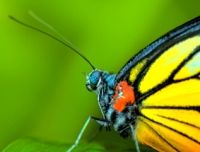

According to a study by Butterfly Conservation, butterfly species have vanished from nearly half of the places where they once flew in the UK since 1976.
The distribution of 58 native species has fallen by 42% as butterflies disappear from cities, fields and woods. Those that are only found in particular habitats, such as wetlands or chalk grassland, have declined even worse, by 68%.
Scientists for Butterfly Conservation, which produced its State of the UK's Butterflies 2022 report from nearly 23 million butterfly records, said there needed to be a "massive step-change" to reverse what it described as "disastrous declines" in insect populations.
The report shows that many of the most endangered species have been revived by targeted conservation action or being successfully reintroduced in specific places, but butterflies and other flying insects continue to vanish from much of Britain.
Richard Fox of Butterfly Conservation, the lead author of the report, said: "We’ve been focused on the most threatened butterfly species, which is stopping them going extinct".
"But there’s a massive challenge revealed by millions of pieces of data in the report, and we need a massive step change in our approach to tackle this and meet the legally binding Government target that now exists for halting the decline of wildlife. This report shows we are not halting the decline of wildlife".
The overall figure for the decline in butterfly abundance is a relatively moderate 6%, but this average figure is obtained from data gathered from nature reserves and nature-rich landscapes, which masks wider population falls. The following species suffered sharp declines in both distribution and abundance:
The grayling fell by 92% in distribution and 72% in abundance between 1976 and 2019.
There have been some successes linked to climate change or conservation action. Global heating has facilitated the expansion further north through Britain of strong-flying species such as the:
Conservation triumphs include the large blue, which was reintroduced using caterpillars from Sweden after its extinction in 1979. Its abundance has risen by 1,883%.
In many cases, although targeted conservation work on certain nature reserves has increased the abundance of rare butterflies, they have continued to vanish from other places, and their range shrinking and their populations losing resilience as a result. The:
This shows that they are no longer able to survive in a large proportion of their former territories, or able to colonise new areas.
The biggest butterfly declines are in England, whereas species have, on average, increased in abundance by 37% and in distribution by 3% in Scotland. Fox said these figures were caused by the huge successes of a few species, such as the comma and the white-letter hairstreak, which have been able to move further north with climate change.
Nevertheless he said this is not a cause for celebration: "Butterflies that you might think of as iconic examples of Scotland’s natural heritage such as the mountain ringlet, Scotch argus and northern brown argus are all doing really badly".
"UK butterflies are by far the best, most comprehensively monitored group of insects anywhere in the world. Butterflies are fulfilling that really important role as an indicator for thousands of other species and the general state of our environment. This report is very gloomy reading on that front".
"It’s going to need bold moves by Government and everyone to take responsibility. Everyone with a garden can help, but the scale of the biodiversity crisis is such that planting a few pollinator-friendly plants is not enough. We need to create habitat where butterflies and other wildlife can live and not just visit for a snack".
Julie Williams, the chief executive of Butterfly Conservation said: "This report is yet more compelling evidence of nature’s decline in the UK. We are totally dependent on the natural world for food, water and clean air. We need swift and effective action on this. The decline in butterflies we have seen in our own lifetimes is shocking and we can no longer stand by and watch the UK’s biodiversity be destroyed".
For more information on this subject, see: